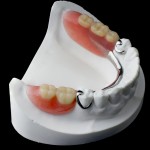
The shortened dental arch (SDA) concept classically consists of 20 occluding teeth (all upper and lower incisors, canines, and premolars) with missing posterior teeth only being replaced if they are considered necessary for appearance or function. This is seen as an alternative approach to the replacement of all missing teeth with fixed (FDPs) or removable dental prostheses (RDPs). The aim of this systematic review was to synthesise the available knowledge from the dental literature about the effects of distal-extension RDPs on the masticatory performance of subjects with moderate or extreme SDA.
Methods
Searches were conducted in the PubMed/Medline, Cochrane Library, Embase, and Science Direct databases Studies on patients with SDA (3-5 posterior occluding pairs) or extreme SDA (0-2 posterior occluding pairs) and on masticatory performance with RDP were considered. Two reviewers independently screened titles and abstracts of the identified records for relevance and abstracted data.
Results
- 8 studies were included; 4 comminution studies, 3 on mixing ability and one on both comminution and mixing ability.
- Comminution or mixing ability in subjects with (E)SDA was 28-39% lower compared to that of subjects with complete dentitions.
- In two studies, comminution outcomes when chewing with an RDP ranged from 2% to 32% reduction, indicating better chewing function (smaller X50) compared to comminution without the RDP.
- One study reported 28-83% lower mixing ability when chewing at the RDP side than chewing at the dentulous side.
- Generally, more artificial teeth (or longer occlusal platform) in experimental RDPs resulted in better comminution and better mixing ability (significant in four out of five studies), indicating a ‘dose-effect’ relationship.
- 2 of the 8 studies reported on biting force with higher maximum occlusal force for biting with natural teeth than for biting with artificial teeth in a distal-extension RDP.
Conclusions
The authors concluded:
Within the limitations of this review, it can be concluded that subjects with (E)SDA had a reduced masticatory performance in the order of 30–40%. Distal-extension RDPs compensated for this reduction only partially, namely in the order of 50%. RDP effects on chewing frequency were not conclusive.
Comments
A broad range of databases has been searched and a clear selection process has been undertaken. However, no assessment of the individual study quality has been presented. Overall the included studies involved a total of just 180 participants with a range of 8-30 patients in each study. While each of the included comminution studies reported on median particle size (X50) a variety of test food were used. There was also variation in the study designs with some being undertaken with and without partial dentures (RPD) and some with different designs of RPD. While the findings suggest that RPD partially compensate masticatory function in those with missing teeth the small number of studies available involving a small overall sample should be taken into account when interpreting the findings particularly as there is known to be a large individual variation between subjects in habitual chewing and swallowing characteristics.
Links
Liang S, Zhang Q, Witter DJ, Wang Y, Creugers NH. Effects of removable dental prostheses on masticatory performance of subjects with shortened dental arches: A systematic review. J Dent. 2015 Oct;43(10):1185-94. doi: 10.1016/j.jdent.2015.05.008. Epub 2015 Jun 8. Review. PubMed PMID: 26066662.

Don’t miss- Partial dentures provide partial compensation for masticatory function http://t.co/meQEc3a6po
Partial dentures provide partial compensation for masticatory function http://t.co/meQEc3a6po
Some improvement of masticatory function with partial dentures http://t.co/meQEc3a6po
Partial dentures provide some improvement of masticatory function http://t.co/meQEc3a6po
My experience has been if the patient is not missing an anterior tooth the likelihood of them wearing a removable goes down significantly. Another concern I have with removables is they put significant stress on the remaining teeth and can act like a bottle opener.
RPD partially compensate masticatory function in those with missing teeth
http://t.co/meQEc3a6po
[…] Partial dentures provided partial compensation for masticatory function […]